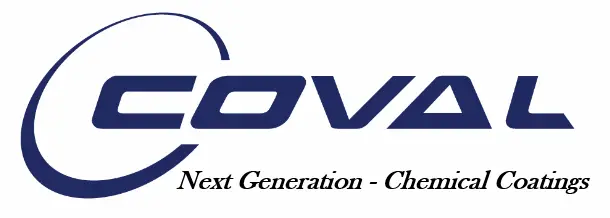Coval Coatings vs. Conventional Coatings

Coval Coatings vs. Conventional Coatings
What is the difference?
To put into perspective what makes Coval Coatings different from conventional coatings we have outlined some of the main elements that should allow you to navigate through this science without being too technical.
Most conventional industrial coatings are based on synthetic polymers --
Extremely large organic molecules. Polymers provide the coating its capacity to adhere to the substrate, most of its chemical resistance, and flexibility.
One of the notable properties of organic polymers is that most are susceptible to damage and degradation by continued exposure to sunlight. Degradation occurs because radiation in the ultraviolet and violet end of the visible spectrum contains sufficient energy to break chemical bonds within the polymer. Energetic solar radiation can create what are known as ‘free radicals’ — atoms, molecules, or ions that have unpaired valence electrons or an open electron shell. These ‘dangling’ electrons make free radicals highly chemically reactive towards other substances, notably the large organic polymer molecules. Free radicals literally tear large organic molecules apart and change their chemical properties — usually in very undesirable ways.
An example — unrelated directly to industrial coatings but familiar to most people — is how energetic solar radiation can create free radicals in skin cells, they modify large organic molecules in our cells — namely the DNA — and can cause a variety of skin cancers.
As radiation-induced degradation occurs, the ability of a conventional coating to provide chemical and corrosion protection also degrades, and this degradation can include whitening of the coating as well as coating delamination.
To compensate for this degradation of organic polymers, manufactures will often add a small percentage of inorganic material, typically a metallic oxide, to protect against this degradation by radiation.


Coval Coatings are just the reverse: we use a far larger proportion of inorganic oxides with a smaller amount of organic polymers.
Coval Coatings proprietary innovative process allows us the ability to combine the best properties of those inorganic oxides with the best properties of organic polymers. The lattice structure of the inorganic oxides (think of the properties of rock or glass) provides strength, hardness, durability, and UV resistance (after all, neither rock nor glass are much affected by solar radiation and have to suffer a significant impact before they break). Nevertheless, that same inorganic lattice structure can typically allow brittle fracture lines along the lattice planes (when rocks do break — they tend to fracture along lattice lines), so the addition of organic
polymer components in Coval Coatings provide elasticity, tensile strength, additional chemical resistance and the capacity to adhere to a variety of substrates.
Unlike conventional polymer coatings, Coval Molecular Coatings are not simply mixed blends of inorganic and organic components: Coval’s unique process reorganizes the organic polymer chains and chemically bonds them within the inorganic lattice structure. A completely new integrated lattice matrix results and retains the best properties of each while eliminating virtually all of the less desirable properties of the components taken individually.
When considering the properties of a superior industrial surface coating almost everyone would agree that it should:
• Be durable,
• Have excellent adhesion (bonding,
cross-linking) to substrate,
• Be easy and convenient to apply,
• Be environmentally safe and sustainable.
Let’s look at some examples of what these
properties imply.
By ‘durable’ we mean, of course, the ability to perform for a long period of time without significant deterioration and includes:
• Corrosion resistance (e.g. chlorides),
• UV resistance, (e.g. free radicals),
• Chemical resistance
• Abrasion resistance.
• Temperature resistance.
As for environmental safety concerns,
Coval Coatings are far below California’s South Coast Air Quality Management’s regulation minimum requirements (easily the most strict in the nation) for volatile organic compounds (VOC’s). They contain none of the isocyanate hardening agents found in most high-performance conventional polymer coatings. Coval Coatings literally harden and cure with the oxygen and the moisture in the air.
Most conventional polymer coatings, and especially those with high performance properties, MIX organic polymers with inorganic additives in the attempt to leverage the desirable properties of both.
The problem with this is that organic molecules and inorganic molecules don’t really like each other; they can be MIXED, but they just don’t “play together well.”
So how then do Coval Coatings overcome this very complex issue between two very different molecules? That is a trade secret, sorry. What we can tell you is that Coval Coatings are manufactured using a very innovative, unique, proprietary, and controlled chemical reaction which COVALENTLY BONDS the inorganic and organic components into one integrated lattice matrix. Using this unique proprietary manufacturing process, they don’t just “play together well”, they literally become an integrated, complementary whole.
Coval Coatings:
- are durable
- are corrosion resistant
- are UV resistant
- are chemical resistant
- are abrasion resistant
- are temperature resistant
- are extremely hard
- are environmentally safe
- have excellent adhesion to substrate
- are easy and convenient to apply, and re-apply
- have high cross-link density bonding to the substrate.
- have high cross-link density bonding to the substrate



